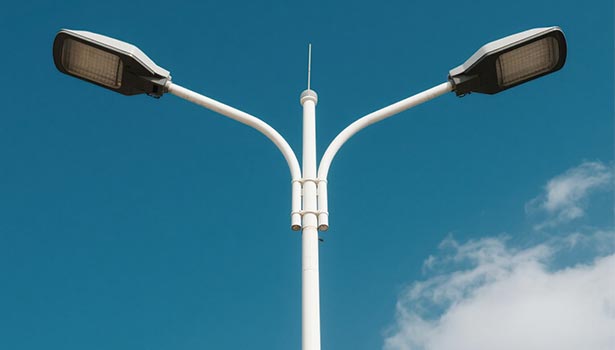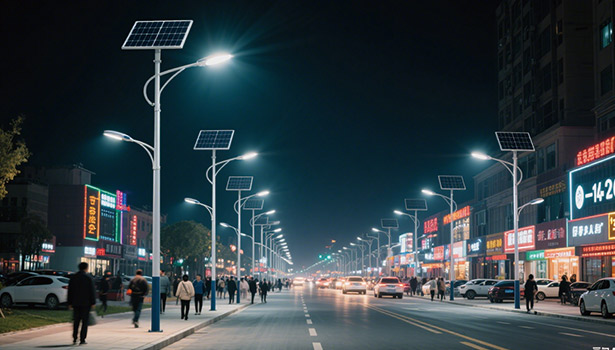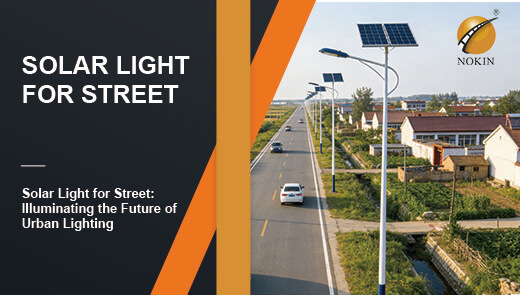What Are the Categories of Solar Street Light Poles
As the core support component of solar lighting systems, solar street light poles must not only bear fixtures, solar panels, and batteries but also adapt to diverse installation environments and functional requirements. Their classification encompasses multiple dimensions including design, material, and installation type. This article provides a detailed analysis of solar street light pole categories to assist you in making precise selections for your projects.

Types of Solar Street Light Poles by Design
Design variations in solar street light poles reflect both aesthetic considerations and specific application scenarios. Poles for sidewalk lighting and highway lighting often differ significantly in structure.
Single-Arm Solar Street Light Pole
This most common design features a main pole connecting all components, with a single cantilever extending outward to support a single LED luminaire. Its simple structure and lower cost make it ideal for areas requiring single-direction illumination, such as one-way streets, sidewalks, and parking lots.
Double-Arm Solar Street Light Pole
As the name suggests, this pole features two arms extending 180° apart from the main shaft. Solar panels are mounted at optimal angles atop the main pole, with some designs incorporating battery enclosures and aesthetic enhancements. Providing dual-direction illumination, double-arm solar street light poles are indispensable for two-way streets and highways.
Conical Solar Street Light Pole
The conical shape refers to the inverted cone structure of the main pole, featuring a larger diameter at the base and a smaller diameter at the top, with an overall tapered profile. This design ensures structural strength while effectively reducing material costs. Conical solar street light poles can be either single-arm or dual-arm designs, offering broad applicability.
Octagonal Solar Street Light Pole
Octagonal solar street light poles excel in wind resistance, making them particularly suitable for windy regions like coastal cities. Their octagonal cross-section enhances connection stability with the base while boosting material mechanical strength, delivering exceptional bending resistance. Compared to aesthetically focused conical poles, octagonal poles prioritize structural integrity.
High-Mast Solar Street Light Pole
The main pole section from base to top is termed the mast. Poles exceeding 50 feet (approximately 15.24 meters) in height qualify as high-mast solar street light poles. These poles feature larger diameters and thicker walls for enhanced stability. They typically mount high-intensity LED solar luminaires at the top, making them ideal for areas requiring extensive illumination such as highways, large parking lots, industrial zones, and stadiums.

Decorative Solar Street Light Pole
Modern minimalist lighting systems often appear lifeless due to excessive functional focus. Decorative solar street light poles, however, stand out through exquisite craftsmanship and intricate designs. They blend traditional aesthetics with modern green technology, concealing components like solar panels and batteries within the pole's protective casing. These poles serve areas like parks, gardens, historical sites, and sidewalks, fulfilling lighting needs while enhancing landscape beauty.
Types of Solar Street Light Poles by Material
The material of a light pole directly impacts its durability, cost, and performance. Different materials suit varying environments and scenarios.
Cement Street Light Poles
Relying on pile foundations for support, these poles are extremely heavy. Transporting them requires specialized heavy equipment, resulting in high shipping costs. Their foundations lack stability, making them prone to tilting or collapse during geological shifts or strong winds, posing significant safety risks. While common a decade ago in cost-sensitive suburban areas, they have largely been phased out due to safety hazards and high maintenance demands. Now only found in rare retrofit projects, their applications have drastically diminished.
Iron Street Light Poles
Constructed from high-strength steel, these poles undergo multi-layer powder coating during production to form a dense protective film. This is further enhanced by hot-dip galvanization, significantly boosting corrosion resistance. Their overall structural strength is exceptionally high, enabling them to withstand strong winds and heavy loads. Combining durability with cost-effectiveness, these poles have become the most common and widely used type in the market, appearing everywhere from urban thoroughfares to rural lanes.
Fiberglass Street Light Poles
As poles made from inorganic non-metallic materials, their molecular structure provides excellent heat resistance, enabling stable operation in high-temperature environments. They also offer outstanding insulation properties, preventing electrical leakage risks, and demonstrate strong resistance to acid and alkali corrosion. However, the material itself has low hardness and poor wear resistance. In daily use, friction or collisions with other objects can easily cause surface wear or even structural damage. This drawback limits their market application to specific corrosion-resistant scenarios, resulting in relatively low usage rates.
Aluminum Alloy Street Light Poles
Crafted from high-strength aluminum alloy and treated with specialized processes, these poles feature high structural integrity to meet standard load-bearing requirements. The surface oxide layer provides exceptional corrosion resistance, while delivering a uniform, aesthetically pleasing finish. Their lightweight design facilitates easy transportation and installation. Compared to pure aluminum, aluminum alloy offers superior workability, simplifying bending, welding, and other fabrication processes. With their durability, broad applicability, and outstanding decorative effects, these poles are widely used in the streetlight industry, particularly suited for scenic areas, commercial streets, and other locations emphasizing aesthetics.

Stainless Steel Street Light Poles
As high-quality steel products with a high chromium content, they form a passivation film that provides exceptional corrosion resistance and electrochemical stability, with performance second only to titanium alloys. While manufacturers commonly apply hot-dip galvanizing for enhanced protection, cold-galvanized poles—featuring a more uniform and dense coating—typically outlast hot-dip galvanized counterparts by 3-5 years in actual use. These high-quality poles carry a relatively higher cost and are ideal for demanding environments like coastal areas and chemical zones requiring exceptional corrosion resistance.
Types of Solar Street Light Poles by Installation Type
Depending on terrain and site requirements, solar street light poles are installed using one of three primary methods:
Embedded (Direct Burial) Poles
Direct burial represents the earliest method for installing light poles, offering simple operation without complex foundation work. However, this installation method provides the lowest durability for solar street light poles and requires detailed soil condition surveys prior to installation.
Anchor-Based (Flange Mounted) Poles
First, construct a sturdy foundation (typically reinforced concrete) and embed the anchor base plate within the concrete. The solar street light pole features a flange at its base, which bolts through holes in the flange to connect with the foundation base plate. This represents the most superior and durable installation method for solar street light poles currently available. Installers can also adjust the pole's angle by tightening or loosening the bolts.
Hinged (Foldable) Poles
Similar to the anchor-based installation, but the foundation plate and pole flange are connected via a hinge, allowing the pole to tilt for easier maintenance. However, this method is more costly and is primarily suitable for standard-height poles.
What to Consider when Choosing Street Light Poles for Your Project?
When selecting solar street light poles for your project, multiple factors must be comprehensively evaluated to ensure the poles meet practical requirements and achieve efficient, stable operation.
Installation Environment
Solar street lights can be installed in diverse locations such as highways, urban roads, rural areas, and even deserts. Environmental parameters like temperature, humidity, wind force, and soil composition vary significantly across these sites, presenting distinct challenges to the poles' physical and chemical properties. For instance, tropical regions experience year-round high temperatures and humidity, occasionally facing severe typhoons. Galvanized steel poles, renowned for their wind resistance and exceptional corrosion resistance, are ideal for such projects.
Illumination Requirements
Many purchasers overlook a critical fact: lighting effectiveness is closely tied to pole configuration. The height of the pole, the tilt angle of the cantilever, and the spacing between two poles all affect the overall illumination of the required roadway area and whether the lighting modules can function efficiently.
Aesthetics
The project team should clearly define the project's positioning. If the project serves both lighting and promotional functions, more effort must be invested in cross-departmental communication, design, and budget planning to select poles that match the overall project style.
Budget and Maintenance Costs
The procurement process for solar street lights should comprehensively consider both short-term and long-term operational costs to make informed decisions. Although solar street lights can operate autonomously from traditional grids when equipped with sensors and control devices, the total cost—including initial investment and ongoing operations—varies significantly. Light poles represent a critical yet often overlooked factor. Some poles have lower initial costs but may incur cumulative maintenance expenses over time; improper pole configurations can also lead to unnecessary investments in other equipment and additional maintenance fees.
Solar street light poles can be categorized into various types based on design, material, and installation method, each suited to distinct scenarios with unique advantages. Selection requires evaluating the project's installation environment, lighting requirements, aesthetic needs, budget, and maintenance costs to identify the most suitable pole. This ensures a solid foundation for the efficient and stable operation of the solar lighting system.




